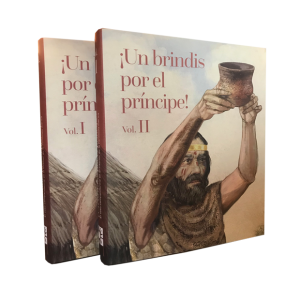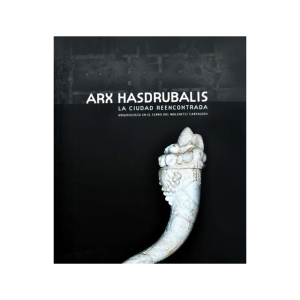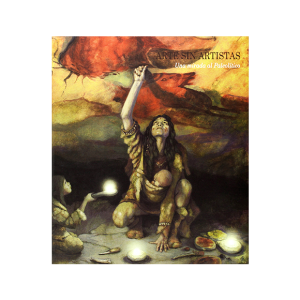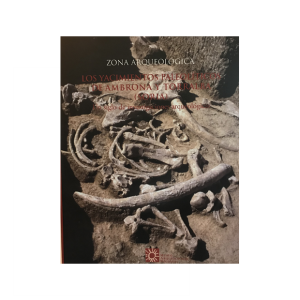Descripción
MOBILE IMAGES OF ANCESTRAL BODIES: A MILLENNIUM-LONG PERSPECTIVE FROM IBERIA TO EUROPE (English)
Mobile images of ancestral bodies: a millennium-long perspective from Iberia to Europe aims to bring the existence and meaning of Idols closer to the public: hidden expressions that are part of the symbolism of the groups of recent prehistory in the Iberian Peninsula. A publication that, in light of the most recent research, brings us closer to the societies that generated them and that used them to maintain social order, invoking lineage and ancestors.
It is an exhaustive study in two volumes belonging to the ZONA ARQUEOLÓGICA collection, nº 23, of the Regional Archaeological Museum, which has been carried out from the investigations carried out for the ÍDOLOS. MIRADAS MILENARIAS exhibition, a project carried out by the Archaeological Museum of Alicante, MARQ, and the Regional Archaeological Museum of Madrid, MAR, which brings together 226 pieces from twenty museums in Spain and Portugal. This book published by the MAR after the exhibition in Alicante and Alcalá de Henares takes advantage of the graphic resources and the language of the panels, making the aesthetics and contents of this exhibition last over time, in which in the last three years put so much enthusiasm and effort, always being aware of the enormous informative and evocative value of our little protagonists, the Idols.
Ídolos, Milenarias Miradas (Catalogue published by the CV MARQ Foundation) also emerged from the cooperation of both institutions, with twenty collaborations that include anthropic figurations from Europe and the Near East, as a reference framework for what happens in the southern half of Iberia; effort that also has the intention of reaching international research circuits, publishing this book in English ‘Mobile images of ancestral bodies: a millenium-long perspective from Iberia to Europe‘ as an integrated volume in the prestigious Archaeological Zone series edited by MAR.
This scientific work aims to make known a spectacular and varied set of images in stone, bone, ivory, clay and gold, which had their peak of use and elaboration between the second part of the IV and the first of the III millennium BC. in the south of the Iberian Peninsula. The human bodies they represent show how prehistoric groups saw themselves, or perhaps more appropriately, how they wanted to be seen. Precisely this idea, how they wanted to be seen, is what gives greater social content to these small pieces that provide unique information about the concept of identity and recognition of origins, gender, lineage and, probably, beliefs.
It has been intended that the most recent research brings us closer to the societies that generated them and that used them to maintain social order by invoking lineage and ancestors.
At the end of the s. In the 19th century, anthropomorphic figures of enormous interest began to be recognized in Spain and Portugal, which were interpreted in the first half of the 20th century as IDOLS, consigning them as a reference to the great Oriental Mother Goddess.
It is a movable set of genuine and schematic representations of the human body and face. Of diverse nature and form, they are confined to the southern half of the Iberian Peninsula, constituting the best testimony of common beliefs that, between 3300 and 2500 BC, characterized the Final Neolithic and Chalcolithic groups with different degrees of social complexity.
INDEX / ÍNDICE VOL. I


INDEX / ÍNDICE VOL. II


MOBILE IMAGES OF ANCESTRAL BODIES: A MILLENNIUM-LONG PERSPECTIVE FROM IBERIA TO EUROPE (Español)
Mobile images of ancestral bodies: a millennium-long perspective from Iberia to Europe pretende acercar al público la existencia y significado de los Ídolos: expresiones oculadas que forman parte del simbolismo de los grupos de la prehistoria reciente en la Península Ibérica. Una publicación que, a la luz de las investigaciones más recientes, nos acerca a las sociedades que las generaron y que se valieron de las mismas para mantener el orden social, invocando al linaje y los ancestros.
Se trata de un exhaustivo estudio en dos volúmenes perteneciente a la colección ZONA ARQUEOLÓGICA, nº 23, del Museo Arqueológico Regional, que se ha llevado a cabo de las investigaciones realiazadas para la exposición ÍDOLOS. MIRADAS MILENARIAS, un proyecto realizado por el Museo Arqueológico de Alicante, MARQ y el Museo Arqueológico Regional de Madrid, MAR, que reúne 226 piezas procedentes de una veintena de museos de España y Portugal. Este libro editado por el MAR tras la exposición en Alicante y en Alcalá de Henares aprovecha los recursos gráficos y el lenguaje de los paneles, haciendo perdurar en el tiempo la estética y los contenidos de esta muestra en la que en estos últimos tres años se ha puesto tanta ilusión y empeño, siendo siempre conscientes del enorme valor informativo y evocador de nuestro pequeños protagonistas, los Ídolos.
De la cooperación de ambas instituciones surgió también como catálogo de la exposición, Ídolos, Miradas Milenarias (Catálogo editado por la Fundación C.V. MARQ) con una veintena de colaboraciones que recogen las figuraciones antrópicas de Europa y el próximo Oriente, como marco de referencia de lo que acontece en la mitad meridional de Iberia; esfuerzo que también tiene la intención de alcanzar los circuitos internacionales de investigación, publicándose el presente libro en inglés ‘Mobile images of ancestral bodies: a millenium-long perspective from Iberia to Europe’ como volumen integrado en la prestigiosa serie Zona Arqueológica que edita el MAR.
Esta obra científica tiene como objetivo dar a conocer todo un espectacular y variado conjunto de imágenes en piedra, hueso, marfil, barro y oro, que tuvieron su punto álgido de uso y elaboración entre la segunda parte del IV y la primera del III milenio a.C. en el Sur de la Península Ibérica. Los cuerpos humanos que representan muestran como los grupos de la Prehistoria se veían a sí mismos, o quizás más apropiadamente, cómo querían hacerse ver. Precisamente esta idea, cómo querían hacerse ver, es la que otorga mayor contenido social a estas pequeñas piezas que aportan una información única sobre el concepto de identidad y de reconocimiento sobre procedencias, género, linaje y, probablemente, creencias.
Se ha pretendido que las investigaciones más recientes nos acerquen a las sociedades que las generaron y que se valieron de las mismas para mantener el orden social invocando al linaje y los ancestros.
En los finales del s. XIX se empiezan a reconocer en España y Portugal figuras antropomorfas de enorme interés que se interpretan en la primera mitad del XX como ÍDOLOS, consignándolas como una referencia de la gran Diosa Madre Oriental.
Se trata de un conjunto mueble de representaciones genuinas y esquemáticas del cuerpo y el rostro humano. De diversa naturaleza y forma se circunscriben a la mitad meridional de la Península Ibérica, constituyendo el mejor testimonio de creencias comunes que, entre el 3300 y el 2500 a.C., caracterizaban a los colectivos del Neolítico Final y el Calcolítico con diferente grado de complejidad social.
LIBROS RELACIONADOS CON LOS ÍDOLOS EN LA PENÍNSULA IBÉRICA:



























Valoraciones
No hay valoraciones aún.